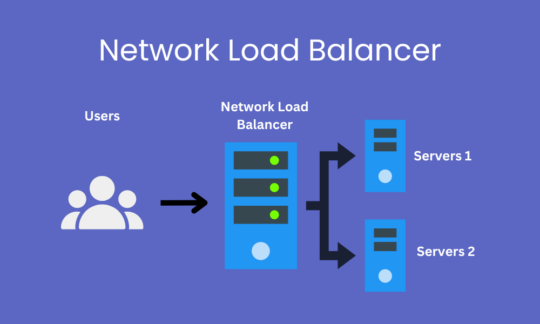In today’s digital era, it is important to keep applications and services updated. This is precisely where network load balancers come into place. They are responsible for distributing incoming traffic across several servers so that no single server is overloaded, ensuring that everything runs effectively and reliably.
What is a Network Load Balancer?
A network load balancer (NLB) is a type of load balancer that operates on the OSI model. In which it operates on transport layer (LAYER 4) of the OSI model. It is designed to handle millions of requests per second while maintaining ultra-low latency. NLBs work best for applications with high throughput and low latency needs, such as real-time gaming, video streaming, and financial services. For example, the AWS Network Load Balancer fronts available applications and manages millions of requests that pour into them per second.
How NLBs Work?
NLB distribute incoming traffic based on various algorithms, such as;
- Round Robin: Following a sequence of potential servers to manage incoming requests.
- Least Amount of Connections: Points to the server that has the minimum number of current connections.
- IP Hash: Requests are routed by the client's IP, maintaining the same routing for a client, or in other words, to be sticky.
Key Features of Network Load Balancers?
- High Performance: NLB handles many connections, which make it the perfect fit for high-traffic applications.
- Low Latency: NLB works efficiently, and it takes less time to process any request, which is critical for real-time applications.
- Scalability: It can handle sudden increases in traffic and maintains consistent performance of ongoing tasks.
- Health Checks: It ensures the health of the backend server is continuously monitored and improves reliability in traffic routing.
- Security: NLBs work with SSL/TLS termination and provide secure connections.
Components of a Network Load Balancer:
Load Balancer Node
It is the point of contact for clients. The incoming traffic from the clients is distributed across multiple targets.
Listeners
Load balancers look out for client connection requests to a particular protocol and port, then they forward this request to target groups.
Target Groups
A load balancer will route traffic to one or more registered targets. It could be, for instance, the EC2 instance as a target.
Health Checks
It keeps checking the health status of the targets so that traffic is only routed to instances that are healthy.
Benefits of Network Load Balancers:
- High Performance: NLBs works on a number of connections simultaneously.
- Low Latency: Minimizes the delay on request processing.
- Scalability: Scales automatically in response to demand.
- Reliability: Only routes traffic to healthy instances, enhancing the availability of your application.
Network Load Balancers Use Cases
- Web Applications: Proper load balancing for high availability and reliability of websites and web applications
- Microservices: For the optimization of performance, the traffic can be routed to the microservices for load balancing
- Gaming: For low latency to the internet for gaming online games
- Streaming Services: For managing video and audio streaming services with huge traffic volumes.
- Financial Services: Delivers transaction speed to applications, specifically banking and financial.
How to Set Up a Network Load Balancer
The steps are as follows to set up an NLB:
- Define Target Groups: Define the server or instance to which traffic is to be directed.
- Set Up Listeners: For incoming traffic on specified ports, set up the listeners.
- Health Checks: Set up health checks to track the server status on the backend.
- Routing Rules: Define how traffic is distributed between servers
Best Practices to Check NLB
- Regular Monitoring: Continuously monitor the performance and health of your NLB with backend servers.
- Security: Support security measures such as SSL, TLS terminations, and DDoS.
- Scalability: An NLB must handle traffic spikes.
- Redundancy: Have multiple NLBs in various regions.
AI and Network Load Balancer
AI optimizes the traffic's distribution and generally enhances the network load balancing, which would help optimize the performance of the network. For example, telecommunications companies use AI to manage network traffic efficiently and ensure seamless connectivity and reduce the costs. Here load balancers create real-time topology adjustments that are powered with the prediction of traffic behavior.
Cloud Computing and NLB
In cloud computing environments, NLBs are highly important to distribute traffic across multiple numbers of servers to achieve high availability and reliability. For instance, the AWS Network Load Balancer helps in managing traffic for applications that are hosted on Amazon EC2 instances in dealing with high volumes of requests during peak times.
The future NLBs will be in the incorporation of things like predictive analytics through technologies such as edge computing. By using these advanced technologies NLB can enhance performance and cut down on latency. For instance, Netflix uses advanced load balancing to manage the vast cloud-based infrastructure and provides smooth streaming services to millions of users worldwide.
Summing UP!
Network load balancers are essential for maintaining the performance, reliability, and security of modern applications. By distributing traffic efficiently and ensuring that only healthy servers are handling requests, NLBs play an important role in delivering a seamless user experience to users.
I hope this blog helps you understand the importance and functionality of network load balancers. If you have any questions or need further details, visit us at WisdomPlexus!
Recommended For You:





